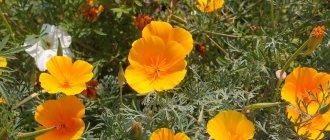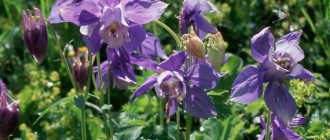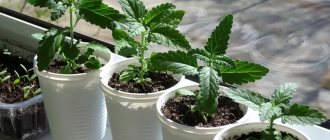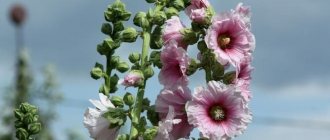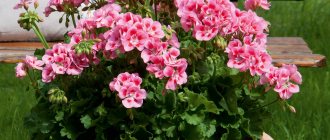Author: Elena N. https://floristics.info/ru/index.php?option=com_contact&view=contact&id=19 Category: Garden plants Published: March 01, 2019Last edits: June 01, 2021
- Pots for seedlings
- Watering
In order for your garden to bloom and smell fragrant from early spring to late autumn, preparations for the beginning of the growing season must begin in winter. Many flowers are propagated by seeds, and in order for them to grow stronger and bloom faster, you need to start growing them before spring, using the seedling method of seed propagation. This is not difficult to do, but you will need special knowledge, which we are ready to share with you.
What flowers are sown for seedlings
First, you need to understand for yourself which flowers can be propagated by seedlings. These include both annual and biennial plants, as well as perennials. Of the annual flowers, those most often sown for seedlings are those that have a long growing season, or if you want the flowers to bloom earlier. In principle, you can grow seedlings of any flowers, except those that do not tolerate transplantation well.
Most often, seeds of the following flowers are sown for seedlings: Chabot carnation, lobelia, petunia, cineraria, snapdragon, sweet pea, zinnia, marigold, nasturtium, cosmos, calendula, mignonette, geranium, gerbera, gaillardia, viola, pansy, primrose, balsam , begonia, verbena, ageratum, aster, clarkia, phlox, gillyflower, salvia, godetia, lupine, lavatera and many others.
Favorable days for sowing flower seeds according to the Lunar calendar in 2022
- Favorable days for purchasing seeds and ready-made flower seedlings: January 4, 10–12, 16, 20–22, 27–28, February 2–3, 7–11, 16, 17–27, 4–17, 19–24, March 29–30, April 1–7, 13–15, 28–29, May 1–15, 25–29, 31, June 1–12, 15–16, 19–20, 23–25.
- In general, days favorable for working with plants in 2022: 6, 10–13, 15, 20–22, 27–28 January, 2–11, 17–20 February, 4–17, 19–24, 31 March, 1 –6, 13–15, 28–29 April, 1–15, 25–28, 29, 31 May, 1–12, 15–16, 21–27 June.
- Favorable days for sowing flowers for seedlings: 2–3, 10–14, 27–28 January, 4–11, 14–15, 25–27 February, 4–5, 8–10, 13–17, 20 March, 1 , 8–9, 13–15, 21–22 April.
- For sowing in the ground and planting seedlings: April 25–26, May 1–15, 31, June 1–12.
- It is better to refrain from sowing seeds: January 4–5, 18, 31, February 1, 16, 21–23, February 28, March 2–3, 18, March 27–28, April 16, 23–24, 30 (evening) , 20–24, 30 May, 14, 17–18, 29 June.
When to plant flower seedlings
What to sow for seedlings in January
Before all other flowers, we sow seedlings of the Shabot carnation, which blooms 5-6 months after sowing, and tuberous begonia, which needs 5.5-6.5 months to bloom. Begonia sown in December-January has tubers that form better and last longer than those sown in March. The bag of seeds usually indicates how much time should pass from sowing the seeds to the start of flowering, and the longer the time period, the earlier the seeds need to be sown. During this period, flower seedlings are sown, the seeds of which must undergo mandatory stratification - stimulation with low temperature.
- Hydrangea: an oriental beauty that loves water
These include aquilegia, spring and stemless gentians, arisema, clematis, princelings, swimsuit, rueberry, jeffersonia, perennial violet, breaker, alpine bell, irises, many bulbous ones, lumbago, lavender, primrose. In January, you need to sow slow-germinating seeds of perennials with a thick or dense shell, if for some reason you do not want to scarify them - mechanically damage or remove the seed shell.
Sowing seedlings in February
In the second month of winter, we continue to sow flowers with a long germination period. It is not too late to sow the seeds of Shabot carnation and flowering begonia. In addition, the time has come to plant those plants that feel good both in the garden and at home - fuchsias, impatiens, pelargoniums, as well as early flowering annuals for hanging baskets that decorate loggias, balconies and glazed terraces - petunia and lobelia, For example.
In February, seeds of angustifolia lavender, sparkling salvia, Wittrock's viola and heliotrope are sown. However, it should be borne in mind that seedlings of some flowers will need long daylight hours, and you will have to provide additional lighting for them.
We sow flowers for seedlings in March
In March, you can plan to grow seedlings of echinacea, fragrant tobacco, verbena, iberis, lobularia, climbing kobe, cleome, bells, herbal carnation, annual phlox, snapdragon, matthiola (levkoya), iberisolia brachycoma and climbing azarina, as well as those flowers which you for some reason did not sow in February.
In the first half of March, you can sow seeds of flowers that grow well both in the garden and at home - pelargonium, coleus, kufei.
In the second half of March, we sow seeds of seedlings of the following annuals: Drummond phlox, celosia, helichrysum, alyssum, venidium, ageratum, arctotis, annual aster, penstemona, castor bean.
What flowers are sown in April
In April, seedlings are sown with zinnia gracilis, tritoma berry (or kniphofia), scabiosa, daisy, perennial delphinium, annual dahlia, cornflower, cotton grass, gatsania, helipterum, godetia, morning glory, calendula, xerantenum, fragrant mignonette, scabiosa, Suvorov limonium, amaranth , aquilegia, kochia (summer cypress), marigolds, as well as those flowers that you did not have time to sow in March - annual aster, venidium, ageratum, lobularia.
Some general information about flowers
Here you will find useful general information that will help novice gardeners in growing flower seedlings.
Annual flowers with small seeds
The record holder for this indicator is begonia. 80 thousand seeds of this flower crop weigh only 1 gram. The following plants have small seeds:
- petunia;
- aggregum;
- purslane;
- Snapdragon;
- fragrant tobacco.
All plants have their own characteristics that should be taken into account when growing seedlings.
Carnation Shabo
Before planting, clove seeds are soaked in a growth stimulant solution for 46 hours. Sowing is carried out in a soil mixture consisting of the following components:
- peat;
- turf land;
- sand.
The seeds are sprinkled with sand on top, which is pre-calcined in the oven. After irrigation, the boxes with crops are covered with glass. Seedlings should be expected 6-8 days after sowing. With the appearance of single shoots, temperatures are lowered by 10 degrees, bringing the thermometer to 14 degrees.
During the period of growing Shabot carnation seedlings, its seedlings need to be pricked twice. The first time this is done is in the phase of the first true leaf. The second pick is made when the plant has 4 true leaves.
Begonia
Seed material is mixed with sand and scattered over the surface of a moist substrate, which consists of the following components:
- turf soil - 2 parts;
- sand – 1 part;
- peat – 1 part.
Glass is placed on the box and transferred to a warm place. Shoots can appear within 1 week, but sometimes you have to wait 3 weeks for them.
Begonia seedlings thrive when the room temperature is maintained at 21 degrees Celsius.
Primrose
A substrate consisting of the following components is well suited for primrose:
- leaf soil;
- turf land;
- sand.
Primrose seeds should be distributed on the surface of the soil mixture and pressed slightly. Then the container is placed in the freezer for 30 days, after covering it with glass. After which the container is removed from the freezer and placed in a semi-shaded room. The temperature in it should be maintained at 17 degrees.
Primrose is a garden plant. When to plant seedlings of primrose flowers and other garden plants is stated above.
Petunia
Petunia seeds should be slightly pressed into moist soil, cover the container with glass and leave to stand at a temperature of 24 degrees until germination. After the first shoots appear, the temperature is lowered by a couple of degrees.
What flowers are grown from seedlings?
All names of flowers that require more than 100 days from germination to flowering can only be grown through seedlings. This category includes:
- verbena;
- Snapdragon;
- delphinium;
- carnation;
- petunia;
- lobelia.
Every gardener can grow healthy and viable flower seedlings. This will require a little effort, patience and application of the new knowledge gained from this article. Good luck!
How to grow flower seedlings
Pots for seedlings
Readers often ask: what is better to grow seedlings in - in boxes or in pots? Of course, it’s better in pots - you sow in a separate container, and then you don’t have to deal with picking the seedlings. The seedling is not injured, the risk of infection with rot is minimized. However, seedlings at home are usually kept in loggias and on window sills, and there is not much space there. If you are not a fan of the seedling method, and you only need three or four containers for seedlings, then, of course, it is better to use pots for seedlings.
But if you have big plans, then it is better to use plastic seedling cassettes with trays, cups or boxes. Don’t get carried away with cardboard containers, especially those for dairy products - now they are treated with some substances that, as they evaporate, inhibit the barely hatched seedlings, causing them to freeze and not develop. The container must be environmentally friendly so that the flower seedlings do not experience discomfort.
The best container for seedlings is peat pots. Their porous walls ensure moisture and air exchange of the root-inhabited soil layer; grown seedlings can be planted in open ground directly in them, without damaging the roots of young plants by removing them from the container. These pots contain no toxic substances or pathogens, and are durable enough in both dry and wet conditions.
A good container for growing small plants are peat tablets for seedlings, which swell when soaked and form a kind of cup filled with peat substrate. This is an ideal dish for seedlings, but small plastic disposable cups for food liquid and large boxes for seedlings are also suitable as dishes for sowing. The main thing is that there are drainage holes in the bottom, and under the bottom there is a tray for excess water.
Soil for flower seedlings
Land for seedlings should have the following qualities: looseness, lightness and porosity of consistency, it should have good air permeability and retain moisture, and also meet the requirements of the crop that you intend to grow in it.
The following components are unsuitable for soil composition: composts of any kind, leaf soil (rotted leaves), rotted manure, wood shavings, low-lying unprocessed peat, untreated turf soil, chopped straw, hay dust, sawdust from wood impregnated with creazote or treated with varnish, unwashed sea sand , quarry sand, unwashed from clay.
- How to correctly calculate the timing of sowing seeds so that the seedlings do not overgrow, but also do not lag behind in growth?
Used to compose the soil: high-moor peat, frozen or weathered lowland peat, meadow sand or sandy loam, but not garden soil, turf soil after heat treatment, sphagnum moss, crushed coniferous bark, dry pine needles, grain husks, crushed peanut shells, river and quartz sand , perlite, vermiculite, agroperlite, granulated foam, crushed pumice and expanded clay. A classic example of a substrate for seedlings: 65-70% sawdust, 25-40% sand.
You can buy soil mixture for seedlings in the store - now there is a huge selection of soils for seedlings. For example, Flower soil from the Living Earth series, Flora soil, Garden Earth soil, Violet soil, Universal soil, and so on. In order to choose the soil you need, you need to know exactly in which substrate your seedlings will grow best, and also study the composition of the soils offered in the store.
Pay attention to the composition of fertilizers in ready-made soil mixtures - their excess may prevent you from seeing your plants bloom. If the amount of phosphorus, potassium and nitrogen in the soil is within 300-400 mg/l, it can only be used as a component for seedling mixture or for planting adult seedlings in it, but it is undesirable to sow seeds in such soil, since the seedlings will turn lushly green, but buds will not form.
Do not use garden soil as a substrate for seedlings, since it is unbalanced in mineral composition and contains pathogenic microflora and pest larvae. But the soil for cacti is suitable for growing seedlings, but before sowing, its acidity should be adjusted by adding dolomite flour, if necessary. It is advisable to sterilize soil for seedlings, whether purchased or prepared by yourself, in an oven or microwave before sowing.
Well, remember about peat tablets - in many cases this is really the best solution.
Lamps
At the end of winter or beginning of spring, the days are still short, and growing seedlings do not have enough daylight hours to develop, so sometimes it is necessary to create artificial lighting for them. What lamps are best to use for this, and how to properly organize the lighting? Immediately exclude incandescent lamps from the list, since they produce an excessive amount of heat, but do not emit the rays that plants need. The choice must be made between energy-saving lamps and phytolamps.
Among the energy-saving lamps for germinating seeds, you should choose induction lamps. Lamps with a warm spectrum will be needed to illuminate seedlings that have entered the flowering phase, and energy-saving daylight lamps are suitable for illuminating seedlings throughout the entire growing cycle. Install these lamps perpendicular to the boxes with seedlings.
Among the colossal number of phytolamps, LED, halogen, sodium and fluorescent lamps are most often used to illuminate seedlings. Usually the choice of gardeners falls on fluorescent lamps, since they produce almost no heat, consume little electricity and have a full spectrum of colors. The advantage of LED lamps is their durability and low energy consumption; in addition, they can emit red and blue colors, which stimulates the rapid growth of seedlings.
Halogen lamps lose heat over time, so they are used much less frequently. Sodium lamps are installed to illuminate small seedlings. For example, one 100 W lamp is enough to illuminate seedlings located on a one and a half meter windowsill. When choosing a phytolamp, consider which lamps will suit you best - wall-mounted, ceiling-mounted or compact ones that give a directed beam.
Picking seedlings
After the first true leaves appear on the seedlings, you should carefully and carefully pick the seedlings into separate containers.
Caring for flower seedlings
Watering
The first watering of the soil is carried out even before sowing, since the seeds are sown in moist soil, but then, until the emergence of seedlings, the soil is not watered - as a rule, under glass or under a film the soil remains moist for a long time. After removing the film, the hatched seedlings are watered regularly so that the soil is always moist, but not wet. With prolonged waterlogging of the soil, there is a risk of root rotting. It is advisable to moisten the soil with seedlings in the first half of the day, since evening watering causes the plants to stretch out and grow sickly and weak.
Water for watering seedlings must be left for 2-3 days. Watering seedlings with melt water gives good results, especially before planting in open ground. Dahlias, fragrant tobacco and nasturtium require frequent watering. And petunia, phlox, purslane, asters, snapdragons, marigolds and zinnia need to be watered only when the top layer of soil is dry. The water temperature for irrigation should be at least 21 ºC. Watering is carried out in different ways: at the root, by spraying from a sprayer, they also use the method of bottom watering - it all depends on what kind of seedlings you are growing.
Temperature
After you have bought and sterilized the seedling substrate, put it in a container, soaked the seeds in Zircon or Epin (this does not apply to purchased seeds that are already prepared for sowing), spread the seeds on the surface, lightly pressed them into the substrate, sprinkle them with a layer of soil , the thickness of which depends on the size of the seed - the planting depth should be three times. In some cases, the seeds are not buried at all, but are only pressed to the surface of the soil.
If you sowed in dry soil, moisten the crop, but only with a spray bottle. Now it's time to build a greenhouse for seedlings. Usually, it is enough to cover the container with film or glass. Sometimes, to speed up the germination of slow-germinating seeds, it is necessary to arrange the bottom heating of the container with sowing to a temperature 2-3 ºC higher than in the room. In any case, you should not keep the container on a cold windowsill, because in addition to good lighting, seeds need warmth to grow. Therefore, place the seeds on a piece of foam or other support so that there is a gap between the window sill and the seed box.
The ideal temperature for germination of seeds of heat-loving crops can be considered 25-30 ºC, and for cold-resistant crops 18-15 ºC. When the seedlings appear and the greenhouse for seedlings is no longer needed, the glass or film is removed, and further development of the seedlings occurs at a temperature of 20 ºC. Of course, these are general recommendations - each plant has its own requirements for both lighting and temperature.
- Daisies: growing in open ground
If you purchased seeds in a store, the factory packaging should contain instructions or recommendations on how to sow the seeds of this particular plant. But if there are no instructions or recommendations on the package of seeds, our website will always be happy to provide you with the information you need, remember this.
Transfer
Picking seedlings should be done on time, when the seedlings develop the first two true (not cotyledon) leaves. If you delay replanting, the seedlings will take root much worse. Why do seedlings dive? In order to increase the area of their feeding, because the growing roots of seedlings take up more and more space. In addition, the seedlings become cramped above the ground surface.
It is best to plant seedlings in peat pots, because when the time comes to plant the plants in open ground, they can be planted in the holes without removing them from the pots, which subsequently do not interfere with the growth and development of the roots. Some flowers do not need picking at all, and plants with long tap roots, so as not to injure them during picking and replanting, should be immediately sown in peat pots one at a time.
If you plant seedlings in a common box, then plant seedlings of large plants up to the very cotyledons at a distance of 5-6 cm from each other, and small ones at intervals of 2.5-3 cm. When transplanting, take the seedling not by the stem, but by the cotyledon leaves, and at the end of the procedure, move the box with seedlings to a dark place for a couple of days.
Top dressing
Two weeks after picking, you need to apply the first fertilizing, which is a solution of mullein 1:10 at the rate of one glass of fertilizer per 8-10 seedlings. After half a month, the seedlings are fertilized with the same composition, but one and a half grams of ammonium nitrate and three grams of superphosphate per liter are added to it at the rate of one glass per 4-5 seedlings. Instead of mullein, you can use bird droppings, and make a second feeding with an ash solution or Agricola for flowers.
Applying fertilizer to the soil is preceded by watering the plants so that the fertilizer does not burn the tender roots of the seedlings. And watch the concentration of the solutions that you prepare for adding to the soil with seedlings: the instructions for preparing solutions indicated on the fertilizer package are designed for feeding adult plants, and you will have to make the solutions twice as weak.
Two weeks before planting seedlings in open ground or moving them to a cold greenhouse, you need to gradually accustom the seedlings to the temperature in which they will find themselves. To do this, seedlings are taken out daily into the yard or onto an open balcony. Cold-resistant plants such as cineraria and antirrhinum begin to be taken out into the fresh air in the shade at an air temperature of 8-10 ºC; for other plants this is too cold, you need to wait until the temperature outside is 10-12 ºC, and only then begin hardening .
At first, staying in the fresh air should last no more than 2 hours; in addition, the plants must be protected from drafts and direct sunlight. Then the plants begin to briefly open to the sun, daily increasing the duration of the seedlings' stay in the fresh air and under the sun's rays. How long your seedlings can tolerate direct rays depends on the characteristics of the crop you are growing. Hardening is a very important procedure; it determines how successful the transplantation of seedlings into open ground will be, and what their further development will be.
Sowing through a stencil
The essence of the method is to sow seeds through a stencil in which small holes are made at equal distances from each other. Therefore, first they make a stencil out of plastic. You can, of course, use other materials, such as cardboard. But a plastic stencil can serve you for more than one year. Holes are made on it using a hot nail or screwdriver. The diameter of the holes is no more than 5 mm, the distance between them is 1-2 cm. The area of the stencil should be equal to the area of the container so that it can easily fit on the ground surface.
Drainage holes are also made at the bottom of the container, and then filled with soil. Perlite or vermiculite is added to the soil to make it loose and light. We compact the soil with a spoon or palm so that the seeds do not go deeper into the soil when watering. We moisten the soil with settled water at room temperature, and add any growth stimulant to the water.
How to sow?
- Place a stencil on the surface of the soil and press it lightly to the ground.
- Sow seeds in cells. To do this, pour the seeds onto a sheet of paper and very carefully pour the seeds into the holes in small portions. If they get on the stencil, then with dry hands we drive them into the cells.
- Carefully remove the stencil.
- Once again, from a distance no closer than 20 cm, we moisten the soil with a spray bottle. Cover the container with film and put it in a warm, bright place.
When to plant flower seedlings in open ground
Seedlings of many flowers are planted in the ground when the threat of spring return frosts has passed - in May or early June. This applies primarily to heat-loving perennials. Planting of seedlings is carried out on a cloudy day or in the evening, when the sun's rays cannot damage seedlings weakened by transplantation to a new place. If we are talking about cold-resistant plants that are not afraid of spring cold snaps, then you can plant them as soon as the earth warms up: tightly squeeze a handful of dry earth in your hand, and then sharply unclench your hand. If the soil falls into pieces, it is ready for the growing season.
Before planting seedlings, tidy up the area: dig up the soil, add fertilizer to it, loosen and level the surface. Manure and compost are added to the soil in the fall, and humus and mineral fertilizers can be applied in the spring. The timing of sowing and planting rates are individual for each plant, but the area where the plants feed should allow them to develop well, that is, they should not grow in crowded conditions. The distance between seedlings when planting is determined by the size, diameter and branching of adult plants.
To plant seedlings, depending on what crop you are planting, grooves or holes are made in the surface of the soil, which must be well watered before planting. Each plant should have at least one liter of water. The seedlings are placed in the slurry formed after abundant watering. If the roots are exposed, they should be spread out well. Then the holes are sprinkled with earth, which is pressed tightly so that all the air escapes. If you did everything correctly, then very soon new leaves will appear on the seedlings, which means that you have completed the task.
Seed preparation
Pre-soaking seeds
When purchasing seeds, the question often arises - how to grow flower seedlings and not destroy them? There are several techniques for this, starting with pre-treatment of seeds before sowing. Soaking does double duty, dissolving chemical compounds in the seed coat and softening it, speeding up germination. The seeds are soaked in warm water for 24 hours, after swelling they are planted in the ground, not allowing to dry out. If for some reason the soaking continues for more than a day, the water must be changed daily.
Seed stratification
Some seeds require the use of cunning to ripen the embryo or to awaken.
With the help of cold, winter conditions are created for them - stratification, by placing a small container with wet sand on the bottom shelf of the refrigerator. Seeds are sown superficially on the sand, covered with a lid and placed in the refrigerator (not to be confused with the freezer). It is necessary to monitor the moisture content of the sand, preventing it from drying out and not being very wet. After the recommended time has passed, the container is removed and placed in a bright, warm place. Sometimes double stratification consisting of alternating several periods of cold and heat is required to grow a plant. For example, tree peonies, yew, cypress, and hellebore have several periods of dormancy and awakening.
Scarification of seeds
There are plants whose seeds are not able to germinate even when soaked, their shell is so dense. Having sowed castor beans, black locusts, sweet peas, and morning glory, you may not see sprouts appear, although the seeds were of high quality and viable. The sprout was unable to break through the thick shell and withered away as a seed. To prevent this, it is enough to violate the integrity of the shell by scratching it or piercing it with a needle, trying not to damage the “eye” - the growth point of the seed. This method of breaking the shell is called scarification (not to be confused with stratification).
morning glory
Germination in a bag
Very small seeds can be germinated in a bag. This method is quite universal and trouble-free. This is done simply; the seeds are sown in a prepared container with soil, either superficially or lightly sprinkled on top, depending on the individual characteristics of the plant. Moisten and place in a transparent plastic bag, tying it tightly. Place the package in a warm place and forget about it for a while.
This mini-greenhouse does not require watering, since the resulting condensate completely provides the crops with moisture. Inspect the crops from time to time, and when sprouts appear, immediately move the containers to a bright place closer to the window, or under additional lighting. If you don’t do this and miss the moment, your extensions will stretch out and may lie down. The temperature during this period is also reduced by several degrees. Do not place sprouted plants in direct sunlight to avoid burns. Accustom your kids to the sun gradually, taking pity on their delicate leaves.
Soaking in medicines for diseases
It is unknown what may await flower crops after germination and what diseases can damage them or even destroy them. There is a risk of this occurring and some measures must be taken to prevent the death of seedlings. To do this, before sowing, the seed material is kept in a 0.1% manganese solution for half an hour and then washed. You can also use special preparations “Fitosporin”, “Stimulin”, which have a good effect, and the drug “Maxim”, intended for treating flower bulbs. They are used strictly in accordance with the attached instructions.
Soil selection and soil preparation
At this stage, it is important to decide on the correct container for the seedlings. It is better to plant in seedling cassettes or boxes. They allow the seeds to receive sufficient oxygen. Before use, the container must be thoroughly cleaned.
The next stage involves quality soil selection and soil preparation.
- The soil must have a soft structure, good moisture permeability and provide sufficient water supply to the seeds. Most often, peat mixtures are used as soil for seeds in the initial stages.
- Later, when planting in seedling cups, the planting holes are also sprinkled with peat.
- Most flower crops have a very developed root system. The result of future crops depends on the degree of soil preparation. Digging up the soil and fertilizing with minerals is mandatory.
- Humus or compost can be used as fertilizer. The use of ash and superphosphates gives good results.
Pay special attention to perennial plants. They need to be fed in the spring, during the formation of the bud and in the last days of flowering.
Annual plants are fed two weeks after planting and in the middle of flowering.
Among gardeners, mullein solution has proven itself well. It is well absorbed by plants and has a beneficial effect on maintaining their immunity.
Preparing soil mixture for a greenhouse
Peat greenhouses are a convenient option for growing. This is special prepared peat with slots provided for planting. It is rich in minerals and has all the necessary conditions for successful plant growth.
Also, you can prepare the land from your site. To do this you need:
- After frost, around the beginning of spring, remove the topsoil of the earth, form piles and cover with dense material.
- Water the soil during the summer.
- After the end of summer, thoroughly sift the soil.
- Add humus and use for planting.
